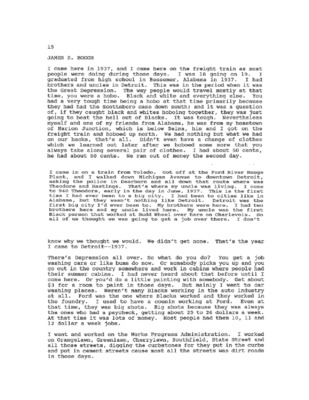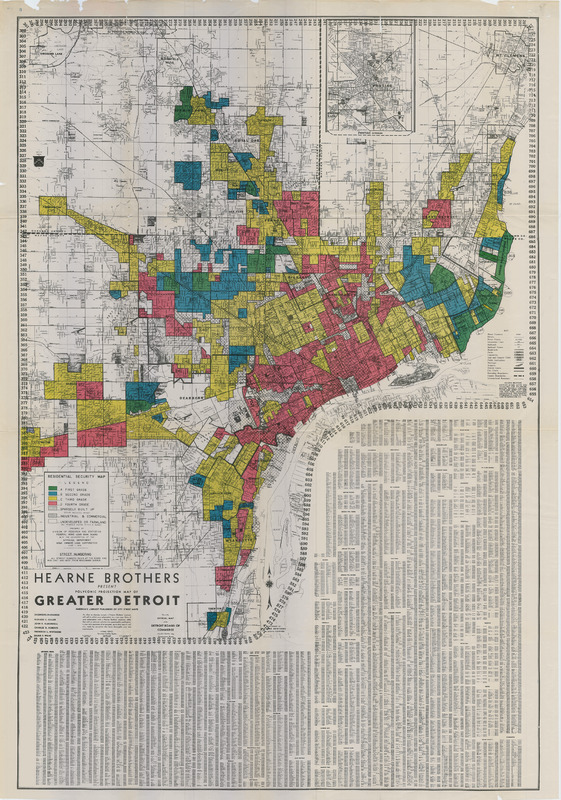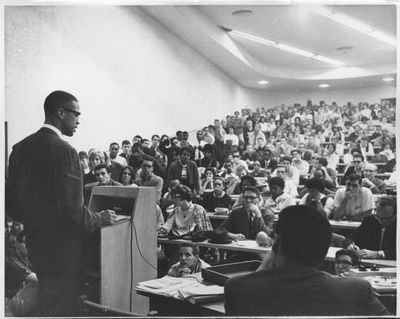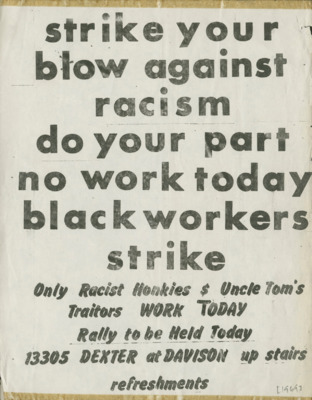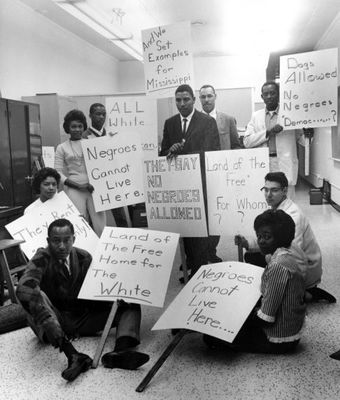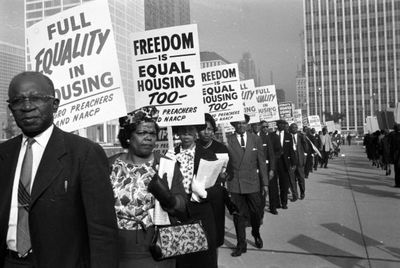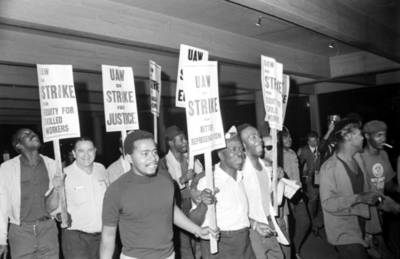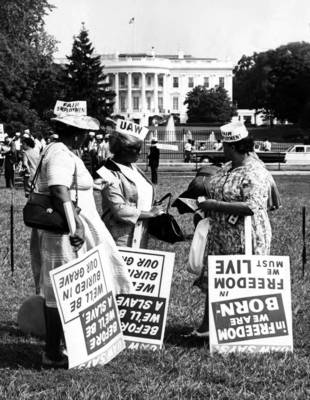The Auto Industry’s Effects on the City of Detroit
Summary
This unit focuses on City of Detroit history, primarily how the auto industry influenced and changed the makeup of the population (migration of workers), along with the challenges the different residents in the communities faced. Students will have an understanding of major historical events in Detroit's past that continue to have an impact on the city today.
Objectives
Students will have a deep understanding of important historical events in Detroit’s history, and understand how these affected Detroit then, and how they still impact the city today.
Standards
-
4 – H3.0.1 Use historical inquiry questions to investigate the development of Michigan’s major economic activities from statehood to present.
-
4 – G5.0.1 Assess the positive and negative consequences of human activities on the physical environment of the United States and identify the causes of those activities.
-
4 – P4.2.1 Develop and implement an action plan and know how, when, and where to address or inform others about a public issue.
-
4 – G4.0.1 Use a case study or story about migration within or to the United States to identify push and pull factors (why they left, why they came) that influenced the migration.
-
4 – H3.0.6 Use a variety of primary and secondary sources to construct a historical narrative about the beginnings of the automobile industry and the labor movement in Michigan.
Inquiry Questions
How did the boom of the auto industry affect Detroit residents?
How did the City of Detroit’s population change with the rise of manufacturing?
How did manufacturing affect Detroit’ economy?
What are some of the challenges new Detroit residents face?
How did people adapt to and change their environment?
How did movement and industrial activities impact the environment of Detroit?
Day 1: Detroit's History on a Clothesline
Overview
Students will research specific time periods and events in Detroit's history in small groups. After each group collects their information we will come together as a class and place all of the events on a clothesline that will span throughout the classroom.
Teachers will assign students specific moments to look up. Consider using consolidated sources like this timeline from the Detroit Historical Society.
Objective
Students develop a general understanding of Detroit’s history including big ideas like the civil rights movement, the auto industry, and creation and need for housing projects.
Standards
4 – H3.0.1 Use historical inquiry questions to investigate the development of Michigan’s major economic activities from statehood to present.
4 – H3.0.6 Use a variety of primary and secondary sources to construct a historical narrative about the beginnings of the automobile industry and the labor movement in Michigan.
Big Question(s)
How did the boom of the auto industry affect Detroit residents?
What are some of the challenges new Detroit residents face?
How did the City of Detroit’s population change with the rise of manufacturing?
Assessment
Evaluate the students' participation in group work and record, and evaluate the event each student included on the timeline with a rubric. The rubric will make sure students display a date of the event, important people in the event, an image (printed or drawn).
Day 2: The Automobile Industry and the Assembly Line
Brief Overview
Students will learn how the use of the assembly line allowed automobile manufacturers to produce cars much more efficiently/quickly. Students will be grouped up and each given a role in the assembly line, where they will create “cars” out of food items, including graham crackers, Oreos, pretzel sticks, and frosting.
Standards
4 - E1.0.1 Identify a good or service produced in the United States and apply the three economic questions all economies must address.
4 - E1.0.5 Explain how specialization and division of labor increase productivity.
Objective
Students will be able to construct “cars” by working together in groups using an assembly line structure.
Day 3: The Great Migration
Standards
4 – G4.0.1 Use a case study or story about migration within or to the United States to identify push and pull factors (why they left, why they came) that influenced the migration.
4 – G4.0.3 Describe some of the movements of resources, goods, people, and information to, from, or within the United States, and explain the reasons for the movements.
Objective
Students will be able to reflect the push/pull factors for the Great Migration in a piece of writing from the point of view of a person who participated in it.
Brief Overview
Read The Great Migration: An American Story by Jacob Lawrence aloud, followed by a whole class discussion on the factors that led to it. Students will then write a short story/journal entry from the point of view of a migrant that moved/was moving from the South to Detroit during this time, including the motivations, thoughts, feelings, hopes, and fears about the move.
Additional Suggested Archival Sources:
Day 4: Civil Rights Letter Writing
Standards
4 – H3.0.6 Use a variety of primary and secondary sources to construct a historical narrative about the beginnings of the automobile industry and the labor movement in Michigan.
Objectives
Students will examine and analyze the civil rights issues and racial tensions of the time period due to the migration and growing automobile industry.
Brief Overview
Students will examine artifacts connected to the effects of the automobile industry, migration, and demographic changes in Detroit. Students will analyze the impact of the subsequent civil and racial tensions using the primary artifacts. They will then write letters to Detroit City Hall as if they were civil rights activists at the time, using the artifacts as evidence to call for improving conditions and civil treatment for Detroit residences.
Day 5: Field Trip to Motown Museum
Standard
4 – G4.0.1 Use a case study or story about migration within or to the United States to identify push and pull factors (why they left, why they came) that influenced the migration.
Objective
Focus on the life of famous Detroiter Barry Gordy to study his life story and how he overcame racism to create Motown, one of the most powerful entertainment companies.
Big Question
Who is Barry Gordy? What effect did he have on Detroit with Motown?
Brief Overview
Students will visit the Motown museum and learn about the history of Barry Gordon’s life and Motown. Students will complete a reflection on what they learned at the museum, and then students will choose a Motown song to analyze as poetry
Day 6: Environmental Impact
Standard
4 – G5.0.1 Assess the positive and negative consequences of human activities on the physical environment of the United States and identify the causes of those activities.
Objectives
Students will analyze the impact of human activity (economic development, rise of manufacturing, growth of factories) on Michigan’s environment.
Brief Overview
Recently, a bill was passed that defunded provisions in the Natural Resources and Environmental Protection Act in Michigan. Students will review videos and articles about the current event, and analyze the potential impact. Then, students will consider the history of Detroit area factories and how it too has impacted Michigan’s environment. Students will then create posters reflecting their thoughts on the importance of environmental laws to counter the impact of human economic activity on the local environment, using examples from the past and present.
Day 7: Sojourner Truth Housing Project Map Activity
Standards
4 – G4.0.1 Use a case study or story about migration within or to the United States to identify push and pull factors (why they left, why they came) that influenced the migration.
4 – H3.0.6 Use a variety of primary and secondary sources to construct a historical narrative about the beginnings of the automobile industry and the labor movement in Michigan.
Objective
Students will view maps, photos and articles to create to own maps with the information they discover. Students will be able to define the term Redlining and how it affects the communities.
Brief overview
Students will view maps, and photos of the Sojourner Truth Housing Project from when it first opened, and what the housing project looks like today. They will explore the term redlining, and what that means for Detroit residents. They will create posters with a map of what the population demographics look like today and one of what the demographics looked like when it opened.
Some images of Sojourner Truth are available at the Library of Congress.
Additional sources:
Day 8: Sojourner Truth Housing Project Compare & Contrast
Standards
4 – G4.0.1 Use a case study or story about migration within or to the United States to identify push and pull factors (why they left, why they came) that influenced the migration.
4 – H3.0.6 Use a variety of primary and secondary sources to construct a historical narrative about the beginnings of the automobile industry and the labor movement in Michigan.
Objective
Students will be able to successfully compare and contrast photo evidence, and draw conclusions based on their observations. Students will also be able to explain the concept of racism, how people sometimes are treated differently due to their appearance or background.
Brief Overview
Students will use a web exhibit from the Reuther Library to view photos related to the Sojourner Truth Housing Projects, specifically the photos that demonstrate how the Detroit Police Department interacted with people of different Races in the same area. Students will be able to explain the two opposing sides.
Day 9: Mock Protest
Standard
4 – P4.2.1 Develop and implement an action plan and know how, when, and where to address or inform others about a public issue.
Objective
Students will learn and understand the effects and successes of Civil Rights protests, while getting to experience their own peaceful protest.
Big Question(s):
What are some of the challenges new Detroit residents face? How can citizens enact change in their communities?
Brief overview
Students will use their understanding of the Civil Rights Movement and what they were fighting for to create posters that are relevant to issues they feel passionate about, and they will create a mock protest around the school.
Before getting out poster-making material, ask the students to take a look at some sources that show people in the past taking a stand. Then, ask them to consider issues that are important to them.
Sources:
Day 10: Field Trip to The Detroit Historical Museum
Standards
4 – G4.0.1 Use a case study or story about migration within or to the United States to identify push and pull factors (why they left, why they came) that influenced the migration.
4 – H3.0.1 Use historical inquiry questions to investigate the development of Michigan’s major economic activities from statehood to present.
Objectives
Students will use their knowledge from all of the previous lessons to explore and make connections with the artifacts and exhibits at the museum.
Brief Overview
The students will explore the museum with a scavenger hunt activity sheet that addresses all of the topics we studied during this unit.
The museum offers a speciality program on the Great Migration that focuses on Detroit women throughout the Great Migrations, their circumstances & how it shaped their lives.
